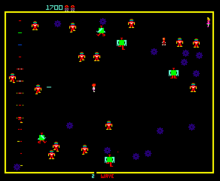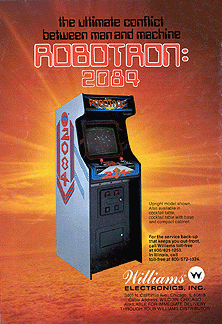Robotron: 2084
The digital 80's
I loved games, and in my infancy I used to be an "adult playing observer", passing hours watching people inserting 25 peseta coins for additional lifespan in Gauntlet, or trying to consume all Out Run's in-game melodies and the colorful USA-wide scroll. Defender, Space Invaders, Galaxian or Donkey Kong are the first ones I remember, full of charm, in bars, mini-golf resources, or swimming pools near León, with a delicious smell to tapas.
Robotron: 2084 (also referred to as Robotron) is an arcade video game developed by Vid Kidz and released by Williams Electronics in 1982. It is a shooting game that features two-dimensional (2D) graphics. The game is set in the year 2084, in a fictional world where robots have turned against humans. The aim is to defeat endless waves of robots, rescue surviving humans, and earn as many points as possible.
The designers, Eugene Jarvis and Larry DeMar, drew inspiration from other popular media: Nineteen Eighty-Four and Berzerk. A two joystick control scheme was developed to provide the player with more precise controls, and enemies with different behaviors were added to make the game challenging. Jarvis and DeMar designed the game to instill panic in players by presenting them with conflicting goals and having on-screen projectiles coming from multiple directions.
Robotron: 2084 was critically and commercially successful. Praise among critics focused on the game's intense action and control scheme. The game is frequently listed as one of Jarvis's best contributions to the video game industry. Robotron: 2084 arcade cabinets have since become a sought-after collector's item. It was ported to numerous platforms, inspired the development of other games, and followed by sequels.
Keywords:
2D computer graphics
3D computer graphics
ACE (games magazine)
Adobe Shockwave
Algorithm
Allgame
Andrew Rollings and Ernest Adams on Game Design
Apple IIe
Arcade cabinet
Arcade game
Arcade system board
Artificial intelligence (video games)
Atari 2600 hardware
Atari 5200
Atari 7800
Automobile accident
Backbone Entertainment
Berzerk
Big Brother (Nineteen Eighty-Four)
Blaster (arcade game)
Blitter
Brainwash
Cathode ray tube
Central processing unit
Character encoding
Commodore 64
Commodore PET
Computing platform
Creative Computing
Cybernetic revolt
Defender (video game)
Edge (magazine)
Electronic Arts
Electronic Gaming Monthly
Eugene Jarvis
Galaxian
Gamasutra
Game designer
Game programmer
GameSpot
GamesTM
Geometry Wars
George Orwell
Gottlieb
Graphics processing unit
Guinness World Records
Halcyon Days (book)
Hertz
IGN
IPhone
Imagine Publishing
International Standard Book Number
Jeff Minter
Killer List of Videogames
Larry DeMar
Level (video games)
Llamatron
McGraw-Hill
Microsoft
Midway Arcade Treasures
Midway Games
Midway's Greatest Arcade Hits
MobyGames
Monaural
Motorola 6809
Multiplayer video game
Nineteen Eighty-Four
Nintendo 64
North American video game crash of 1983
Orwellian
Pearson Education
Pixel
PlayStation
PlayStation 2
PlayStation Network
Playtest
Porting
Random House
Raster graphics
Retro Gamer
Revolution
Robotron
Running Press
Science fiction
Scrolling
Shareware
Shoot 'em up
Single-player video game
Smash TV
Space Invaders
Spring (season)
Springer Science+Business Media
Stargate (video game)
Stern (game company)
Superhuman
Texas Instruments TI-99/4A
Text-based game
Three Rivers Press
Top-down perspective
Total Carnage
Trajectory
Vid Kidz
Video game
Video game developer
Video game genres
Video game industry
Video game publisher
Video game remake
WMS Industries
Williams Arcade's Greatest Hits
Williams Electronics
Xbox Live Arcade
Ziff Davis
Content extracted from Wikipedia, where you can find its license details.
Ignacio Javier Gómez Rodríguez (igjav). OS developer. Naive power.







